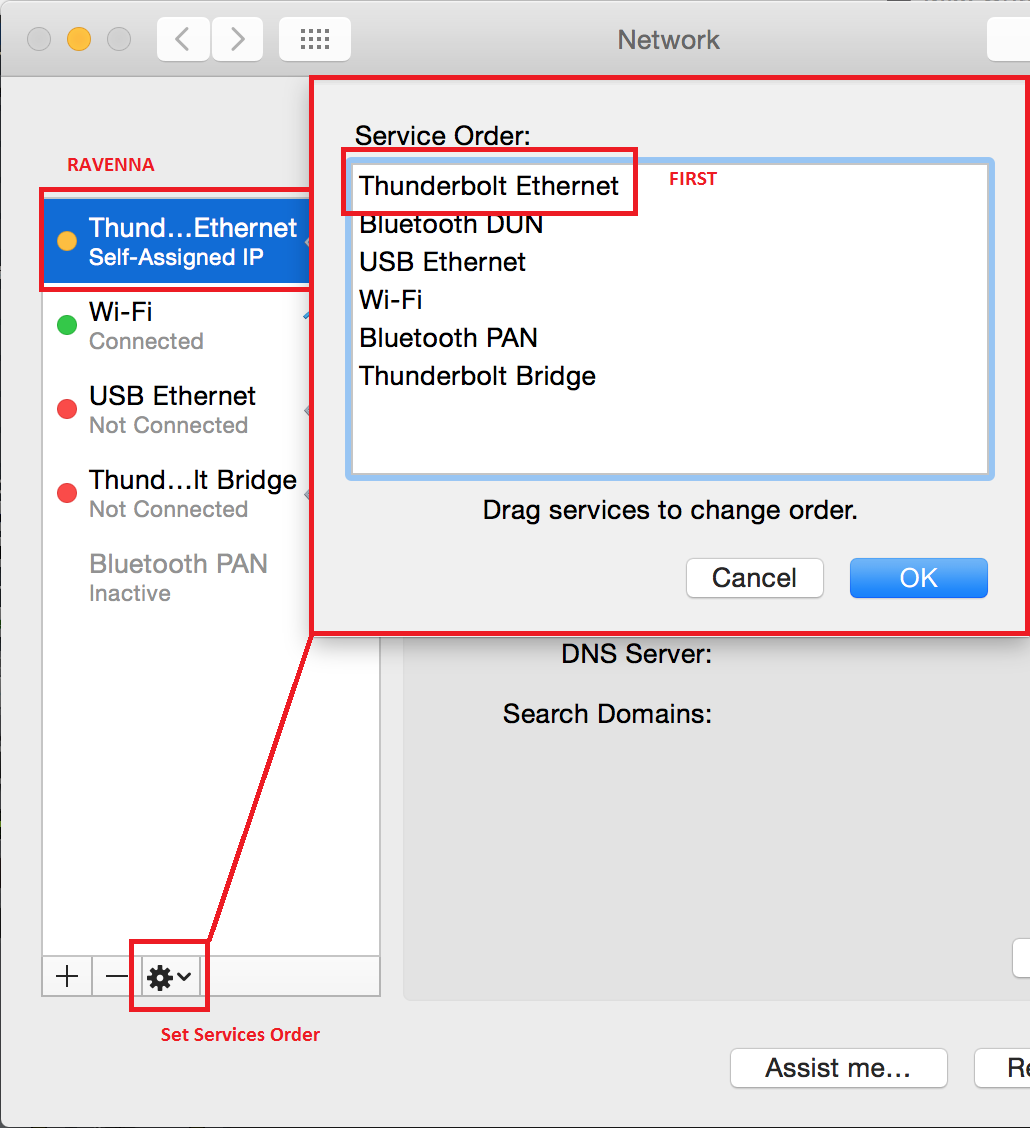MacOS 10.10 Yosemite Optimizations and Troubleshooting
Optimize Energy Saver
This optimization will free up system resources as well as prevent the computer from going to sleep or standby mode which can cause audio dropouts with software and hardware.
- Open System Preferences.
- Click 'Energy Saver'.
- Do one of the following (available option depends on your computer model).
- If present, set the 'Computer sleep' slider to 'Never'
- Otherwise, check the box that says 'Prevent computer from sleeping automatically when the display is off.'
- Un-check the box for 'Put hard disks to sleep when possible'.
Turn off Wi-Fi
If your computer is equipped with Bluetooth wireless and/or a Wi-Fi (AirPort) card, these may need to be disabled for DAW to work correctly.
- Open System Preferences.
- Click 'Network'.
- On the left hand sidebar, click on Wi-Fi.
- Click on the button that says Turn Wi-Fi Off.
Set Ravenna Network Service Order first
Disable FileVault protection
This optimization will allow your hard drive to work more efficiently.
- Open System Preferences.
- Click 'Security & Privacy'.
- Click on the 'FileVault' tab.
- In this window find where it states: 'FileVault protection is (on/off) for the hard disk...'.
- If FileVault is on, click the button to 'Turn Off FileVault'.
Disable Firewall
This optimization will allow your network to work more efficiently.
- Open System Preferences.
- Click 'Security & Privacy'.
- Click on the 'Firewall' tab.
- In this window find where it states: 'Firewall: On'.
- If Firewall is On, click the button to 'Turn Off Firewall'.
Automatic Updates
Some updates to your Mac software can cause conflicts with your DAW. Therefore, it is suggested to disable the automatic update functionality within the operating system.
If there is an update that you need, you can manually update your Mac software my clicking on the Apple menu in the upper left corner of your screen and choosing Software Update.
- Open System Preferences.
- Click 'App Store'.
- Make sure the box labeled 'Automatically check for updates' is unchecked.
Disable App Nap
App Nap can negatively affect EuControl by causing response time delays when changing parameters on a control surface. This is because the OS appears to see this app as 'idle' since it is hidden from view.
If you are using a EuCon surface such as an Aritst Mix or S6, disabling App Nap is recommended:
- Go to your Applications folder.
- Go to the Euphonix folder.
- Right-click or control+click the EuControl application and choose Get Info.
- In the EuControl Info window, under General, you will see an option to prevent App Nap.
Enable Spotlight Indexing
DAW relies on Spotlight indexing for Workspace database search operations. It is therefore suggested that Spotlight be allowed access to all mounted drives.
This will be the default on Yosemite, but to be sure nothing is hidden from Spotlight please follow these steps:
- Open System Preferences.
- Click 'Spotlight'.
- Click on the Privacy tab.
- Be sure no drives appear in this list. It should be empty.
- If any drives do appear, highlight each one and click the minus (-) button below the list to remove them.
Disable Sudden Motion Sensor (For laptops only, and not available on all models)
If you're recording in a loud environment, this optimization will prevent the Sudden Motion Sensor from kicking in and throwing errors.
- Double-click on the Macintosh HD icon on your desktop. (This would be your system drive if you have renamed it to something else.)
- Go to the Applications folder.
- Go to the Utilities folder.
- Double-click on Terminal.
- Type sudo pmset -a sms 0 and press Return. (Typing in '0' disables it.)
- Enter your administrator when prompted.
- Type sudo pmset -g to verify that this has been applied.
To re-enable Sudden Motion Sensor:
- Go back to Terminal following the above steps.
- Type sudo pmset -a sms 1 and press Return. (Typing in '1' re-enables it.)
- Enter your administrator when prompted.
- Type sudo pmset -g to verify that this has been applied.
Repair Disk Permissions
- From the Finder, click the 'Go' menu and select 'Utilities'.
- Double-click on Disk Utility.
- Select the boot volume. (This would be called 'Macintosh HD' unless you have renamed it to something else)
- Go to the 'First Aid' tab and select "Repair Disk Permissions".
Remove Login Items
Login Items are applications that will automatically start when logging into a user account. Remove unnecessary login items to reduce sources of potential conflicts with your DAW.
- Open System Preferences.
- Click 'Users & Groups'.
- Select the account you're logged into on the left hand side.
- Click Login Items.
- Go through the list and select each item, one at a time, and click the '-' below the list to remove the item (as long as you do not absolutely need it to start at login).
Remove Startup Items
Startup Items are similar to Login Items, but will start when first booting the computer, regardless of the user account being utilized. To remove unnecessary Startup Items
- Open your Macintosh HD.
- Go to the Library folder.
- Go to the StartupItems folder.
- Delete any unnecessary item.
- NOTE: Although the OS does not rely on anything in this folder to operate, please double-check the functionality of any unknown Startup Items before deleting them to ensure that you're not losing any essential functionality.
